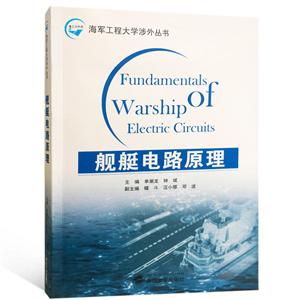扫一扫
关注中图网
官方微博
本类五星书更多>
-
>
闯进数学世界――探秘历史名题
-
>
中医基础理论
-
>
当代中国政府与政治(新编21世纪公共管理系列教材)
-
>
高校军事课教程
-
>
思想道德与法治(2021年版)
-
>
毛泽东思想和中国特色社会主义理论体系概论(2021年版)
-
>
中医内科学·全国中医药行业高等教育“十四五”规划教材
舰艇电路原理 版权信息
- ISBN:9787307189126
- 条形码:9787307189126 ; 978-7-307-18912-6
- 装帧:一般胶版纸
- 册数:暂无
- 重量:暂无
- 所属分类:>>
舰艇电路原理 本书特色
本书以舰艇构造与系统为主线,主要解答了舰艇的基本概念、舰艇的总体构成、舰艇的系统构成、舰艇的部门构成及潜艇人员培训等方面的问题。全书共分14章,分别就舰艇电路的原理、集成、线性电路元件、受控源、电路复位技术、电路分析技术等方面介绍了舰艇电路相关知识。
舰艇电路原理 内容简介
本书以舰艇构造与系统为主线,主要解答了舰艇的基本概念、舰艇的总体构成、舰艇的系统构成、舰艇的部门构成及潜艇人员培训等方面的问题。全书共分14章,分别就舰艇电路的原理、集成、线性电路元件、受控源、电路复位技术、电路分析技术等方面介绍了舰艇电路相关知识。
舰艇电路原理 目录
Chapter 1 Circuit Model and Kirchhoff's laws
1.1 Circuit and Circuit Model
1.2 Voltage and Current and Their Reference Direction
1.3 Kirchhoff's Laws
1.4 Passive Circuit Elements
1.5 Active Circuit Elements
1.6 Example of Computer-Aided Analysis of Circuits
Exercise
Chapter 2 Equivalent Resistive Circuits
2.1 The Equivalent Circuit of One-Port Network
2.2 Equivalent Resistance of Passive One-Port Networks
2.3 Delta-to-Wye Equivalent Circuits
2.4 Equivalent Simplification of Active One-Port Networks
2.5 Equivalent Simplification of Controlled Source Circuit
2.6 Example of Computer-Aided Analys of Circuits
Problems
Chapter 3 Systematic Analysis of Circuits
3.1 The Basic Concept of Graph Theory
3.2 2b Method and Branch Analysis Method
3.3 Loop Analysis and Mesh Analysis
3.4 Node Analysis and Modified Node Analysis
3.5 Example of Computer-Aided Analysis of Circuits
Problems
Chapter 4 Circuit Theorems
4.1 Superposition Theorem
4.2 Substitution Theorem
4.3 Thevenin's Theorem and Norton's Theorem
4.4 Tellegen's Theorem and Reciprocity Theorem
4.5 Computer-Aided Analysis of Circuits
Exercise
Chapter 5 Sinusoidal Steady-State Analysis
5.1 The Basic Concept of Sinusoidal Quantity
5.2 Phasor Representation of Sinusoidal Quantity
5.3 Kirehhoff's Laws and VCR in Phasor Form
5.4 Impedance and Admittance
5.5 Analysis of Sinusoidal AC Circuit
5.6 Power in Sinusoidal AC Circuit
5.7 Examples of Computer-Aided Analysis of Circuits
Problems
Chapter 6 Magnetically Coupled Circuits
6.1 Mutual Inductance and VCR of the Coupled Inductor
6.2 Analysis of Coupled Inductor Circuit
6.3 Air-Core Transformer and Ideal Transformer
6.4 Examples of Computer-Aided Circuit Analysis with Matlab
Exercises
Chapter 7 Resonant Circuit Analysis
7.1 Series Resonant Circuit
7.2 Parallel Resonant Circuit
7.3 Examples of Computer Aided Circuit Analysis
Exercises
Chapter 8 Three-Phase Circuits
8.1 Balanced Three-Phase Circuits
8.2 Unbalanced Three-Phase Circuits
8.3 Power of Three-Phase Circuits
Exercises
Chapter 9 First-Order Circuits
9.1 The Basic Concept and Circuit Switching Rule
9.2 Zero-Input Response of First-Order Circuit
9.3 Zero-State Response of First-Order Circuit
9.4 Short-Cut Method for Complete Response of First-Order Circuit
9.5 Step Response and Impulse Response of First Order Circuit
Exercise
Appendix A Experiment
Appendix B Reference Answers for Partial Exercises
References
展开全部
舰艇电路原理 作者简介
单潮龙,男,浙江临海人,1964年6月生,现任海军工程大学电气工程学院教授,博导,研究方向为电气工程、电力系统电磁兼容。
书友推荐
- >
上帝之肋:男人的真实旅程
上帝之肋:男人的真实旅程
¥20.2¥35.0 - >
史学评论
史学评论
¥14.4¥42.0 - >
推拿
推拿
¥12.2¥32.0 - >
朝闻道
朝闻道
¥14.8¥23.8 - >
月亮虎
月亮虎
¥15.4¥48.0 - >
人文阅读与收藏·良友文学丛书:一天的工作
人文阅读与收藏·良友文学丛书:一天的工作
¥15.7¥45.8 - >
巴金-再思录
巴金-再思录
¥15.7¥46.0 - >
罗曼·罗兰读书随笔-精装
罗曼·罗兰读书随笔-精装
¥32.9¥58.0
本类畅销
-
UG NX 10.0模具设计教程
¥38.2¥59 -
计算机组成原理(微课版)
¥45¥69.8 -
电路基础/于宝琦
¥31.9¥49 -
通信电源
¥23.9¥38.8 -
计算机操作系统-(第四版)
¥19¥53 -
科学技术概论
¥30.4¥49
浏览历史
医学高等数学(第2版)
¥38.3¥49.8数理统计
¥71.2¥89.0突发性洪水预报预警
¥104.0¥160.0中学生物学教材分析
¥27.0¥40.0工程项目成本管理学
¥34.6¥42.0

















